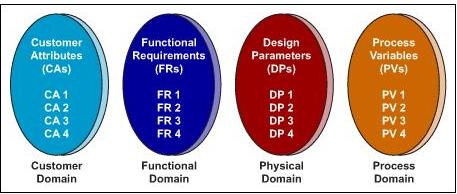Posts Tagged ‘Functional Domain’
Small Is Good, And Powerful
 If lean has taught us anything, it’s smaller is better. Smaller machines, smaller factories, smaller teams, smaller everything.
If lean has taught us anything, it’s smaller is better. Smaller machines, smaller factories, smaller teams, smaller everything.
The famous Speaker of the House, Tip O’Neill, said all politics are local. He meant all action happens at the lowest levels (in the districts and neighborhoods), where everyone knows everyone, where the issues are well understood, and the fundamentals are not just talked about, they’re lived. It’s the same with manufacturing. But I’m not talking about local in the geography sense; I’m talking about the neighborhood sense. When manufacturing is neighborhood-local, it’s small, tight, focused and knowledgeable.
We mistakenly think about manufacturing strictly as the process of making things—it’s far more. In the broadest sense, manufacturing is everything: innovation, design, making and service. It’s this broad-sense manufacturing that will deliver the next economic revolution.
Previously, I described how big companies break themselves into smaller operating units. They recognize lean favors small, and they break themselves up for competitive advantage. They want to become a collective of small companies with the upside of small without of the downside of big. Yet with small companies, there’s an urge to be big.
Lean says smaller is better and more profitable. Lean says small companies have an advantage because they’re already small. Lean says small companies should stay small (neighborhood small) and be more of what they are.
Small companies have a size advantage. Their smaller scope improves focus and alignment. It’s easier to define the mission, communicate it, and work toward it. It’s easier to mobilize the neighborhood. It’s clearer when things go off track and easier to get things back on track. At the lowest level, smaller companies zero in on problems and fix them. At the highest, they align themselves with their mission. These are important advantages, but not the most important.
The real advantage is deep process knowledge. Smaller companies have less breadth and more depth, which allows them to focus energy on the work and develop deep process knowledge. Many large manufacturers have lost process knowledge over the years. Small companies tend to develop and retain more of it. We’ve forgotten the value of deep process knowledge, but as companies look for competitive advantage, its stock is rising.
Lean wants small companies to build on that strength. To take it to the next level, lean wants companies to think about manufacturing in the more-than-making sense and use that deep process knowledge to influence the product itself. Lean wants suppliers to inject their process knowledge into their customers’ product development process to radically reduce material cost and help the product sprint through the factory.
The ultimate advantage of deep process knowledge is realized when small companies use it to design products. It’s realized when people who know the process fundamentals work respectfully with their neighbors who design the product. The result is deeper process knowledge and a far more profitable product. Big companies like to work with smaller companies who can design and make.
Tip O’Neill and lean agree. All manufacturing is local. And this local nature drives a focus on the fundamentals and details. Being neighborhood-local is easier for small companies because their scope is smaller, which helps them develop and retain deep process knowledge.
Lean wants companies to be small—neighborhood-small. When small companies build on a foundation of deep process knowledge, sales grow. Lean wants sales growth, but it also wants companies to reduce their size in the neighborhood sense.
Assess Design Alternatives With Axiomatic Design
Al Hamilton, of Axiomatic Design Solutions, wrote a good article on how Axiomatic Design can be used to evaluate multiple design alternatives.
Here is an excerpt from the article:
Axiomatic design breaks the design process into four domains, shown in Figure 1. The customer domain can be thought of as the voice of the customer (VOC).
- The functional domain is initially populated by mapping the VOC into independent measurable functions. High-level functions are driven by the customer; lower-level functions are driven by design choices. Every function must be measurable.
- The physical domain is the domain of physics, chemistry, math and algorithms.
- The process domain is where the specifics of how the design parameters identified in the physical domain will be implemented.
Dr. Mike Shipulski, director of engineering at Hypertherm, a manufacturer of plasma cutting systems, has made extensive use of axiomatic design. Shipulski observes, “By first defining the functions we are to achieve, we align our problem solving on the right areas and broaden possible design opportunities. With axiomatic design, we have a framework for avoiding problems that are often detected only during system-level testing.”

 Mike Shipulski
Mike Shipulski